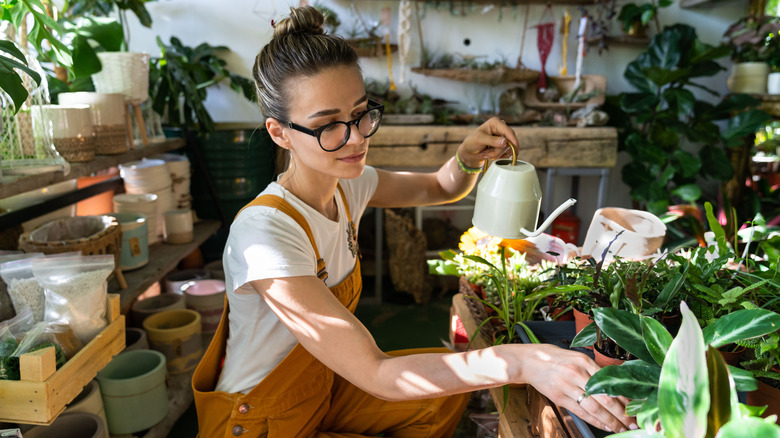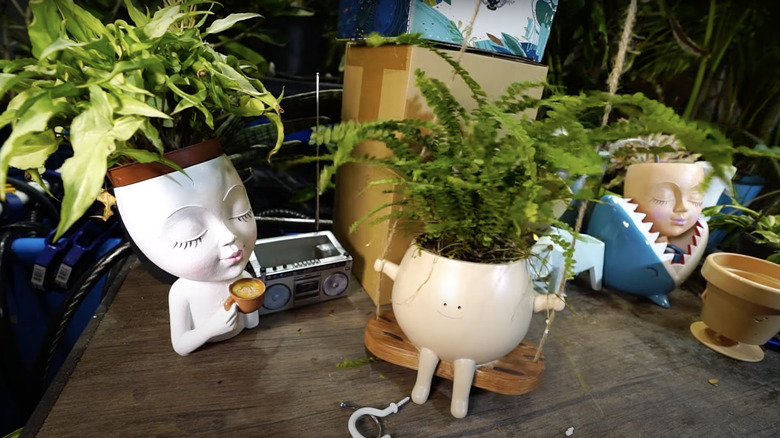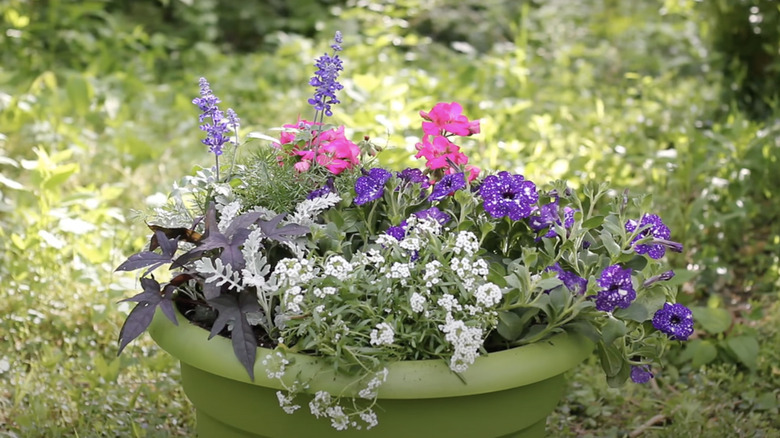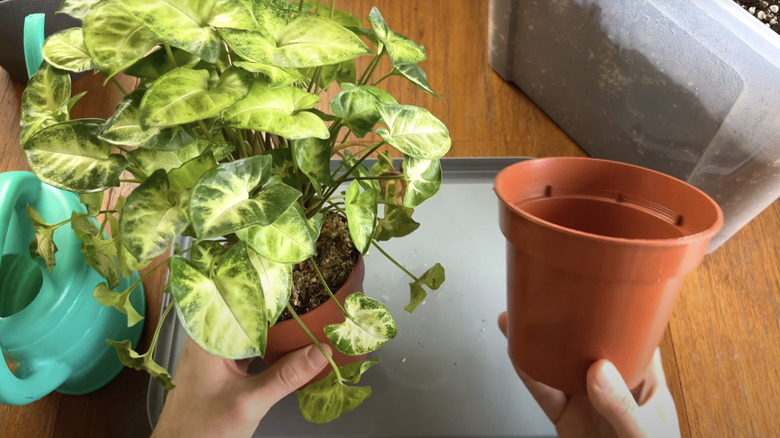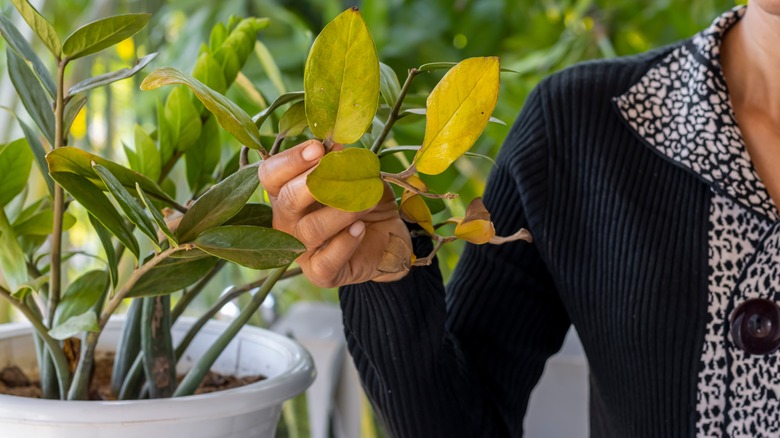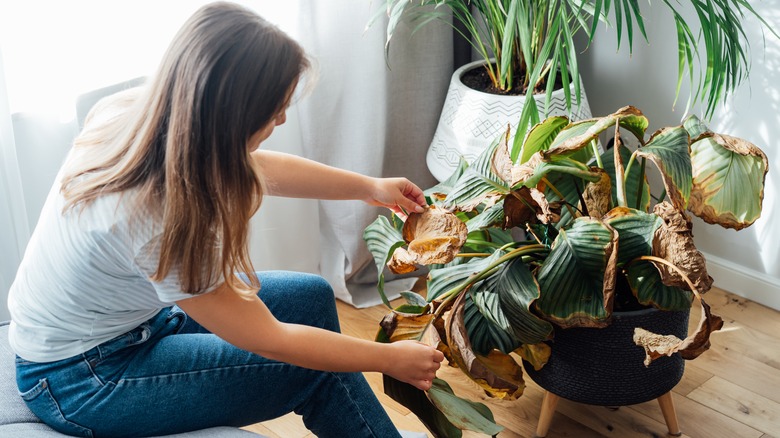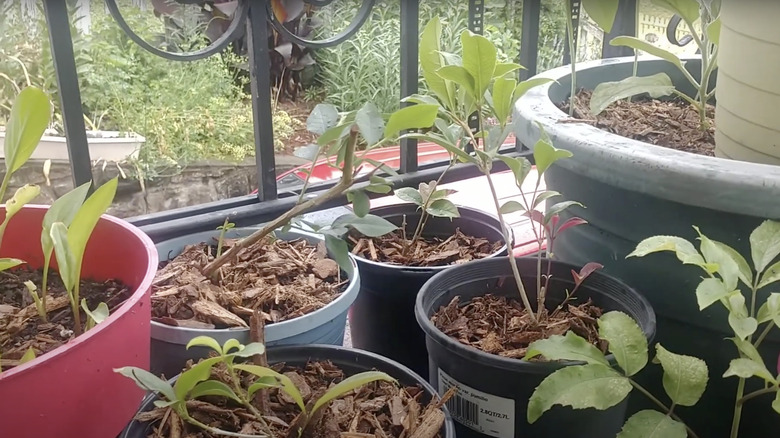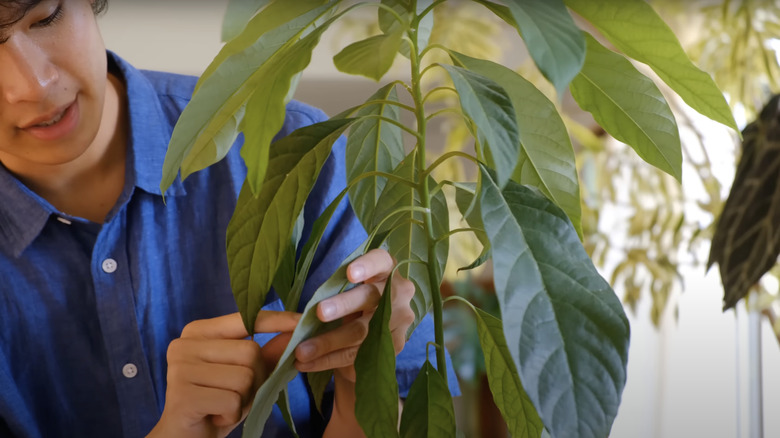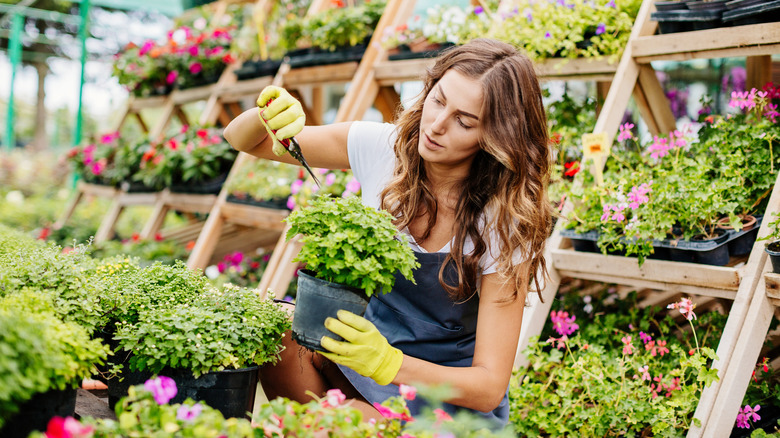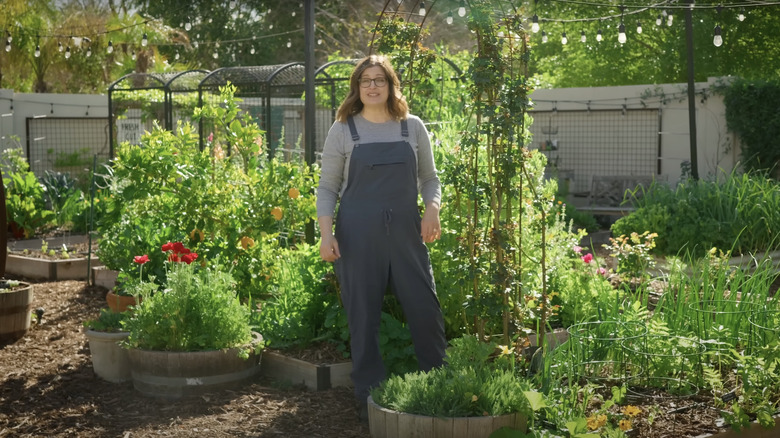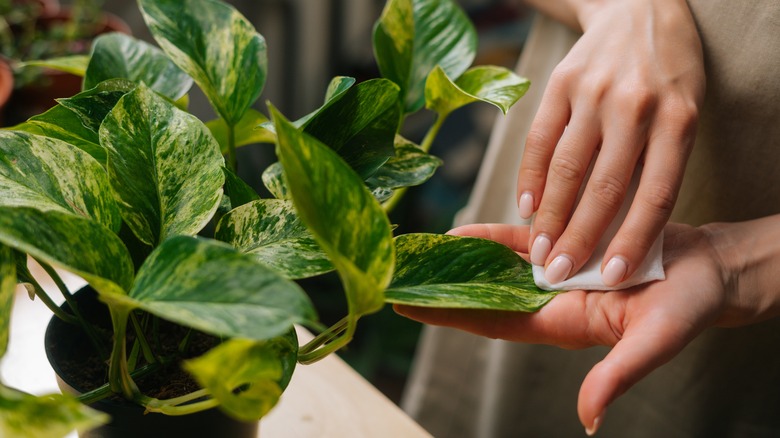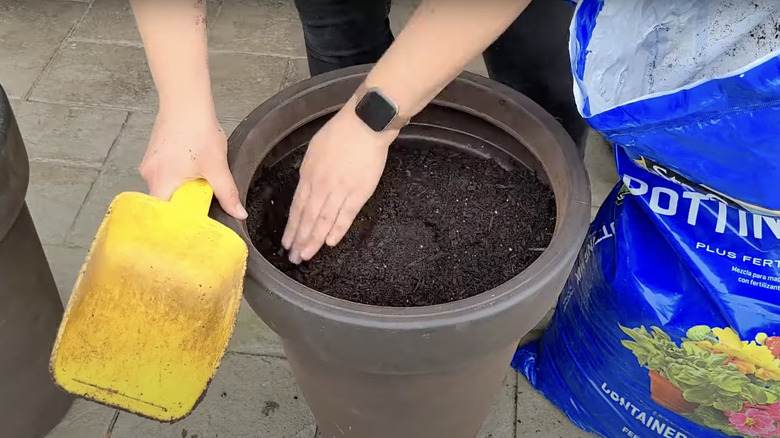The Biggest Mistakes You're Making With Your Container Garden
We may receive a commission on purchases made from links.
Planting a garden is a wholesome way to put down some roots. Whether you cultivate indoor or outdoor plants, container gardening could be the hobby for you. Container gardening differs from traditional practices since plants are placed in containers rather than directly in the soil. You can take them with you wherever you move, and the pots themselves add a unique touch to your home's appearance.
Although this form of gardening has more versatility and freedom, it also has limitations. Special challenges arise when gardening in pots or other receptacles. If you have little experience raising greenery, you could make a mistake that puts your flowers, grasses, herbs, and other plants at risk. Learn more about common mishaps in container gardening below so you can do your best to avoid these frequent blunders.
Choosing an ornamental planter over a functional one
Designing a container garden provides double the excitement of in-ground gardening since you get to choose both your pots and plants. Standard pots and planters are the norm, but you can use any type of container to house your greenery, including DIY projects, repurposed plastic jugs, kitchen bowls, baskets, trash cans, buckets, and other concave objects. They can be standing or hanging designs. There is only one rule: make sure your container of choice has a drainage hole. A drainage hole ensures excess water drains out the bottom and doesn't sit and oversaturate your plants.
If you're deadset on an ornamental planter that doesn't have a drainage hole, there are some alternative solutions. One option is to put your plants in a smaller, properly draining container inside the decorative planter. Another option is to drill the holes yourself. Use Amazon's hole saw set and electric drill to put holes in the bottom of your container. Using this set, you should be able to make ceramic, glass, stonework, and wood receptacles livable for your plants. If you need more in-depth instructions or want to know about the risks involved, check out Clever Bloom's step-by-step guide.
Not knowing the difference between thrillers, fillers, and spillers
When setting up a container garden, many follow the "Thriller, Filler, Spiller" design approach. This term refers to the three types of plants to incorporate in your container setup to make it aesthetically pleasing. Thrillers add height to the greenery arrangement, fillers fill up the sides, and spillers hang over the edge.
When choosing your thriller, opt for any plants that grow upwards, such as tall grasses. Your filler can be more than one species, like annual flowers and cooking herbs. Your grand finale, the spiller, should be something that drapes over the side of a planter, such as trailing plants. Just make sure you do your research or ask your local nursery for help before committing to an arrangement since you need to ensure they're compatible. If you need more details on properly arranging these pots, Proven Winners has helpful placement advice.
The only time you should skip one of the three is when using a smaller container without space for so many plants. If you're using a unique receptacle or narrow plant pot, simply one or two types of plants will do. Ivette Solar tells Garden Rant, "It [Thriller, Filler Spiller] exists precisely to make things simple, to give you a template that you don't need to vary." In short, you should follow this template as a general guide, but don't let it stop you from deviating to make a prettier garden that suits your personal tastes.
Not planting in a container that accommodate your plants' growth
Imagine you've picked out your plants and their containers and are ready to start container gardening. Everything seems perfect until you realize you forgot a vital detail– your plants may not be fully grown. Popular gardening stores and local nurseries often sell plants on the cusp of adulthood, ensuring they have a fighting chance in their new home but also have many years ahead of them. Young plants often have more growing to do, and your chosen pot may not suffice as long-term shelter. When plants outgrow their pots, they become rootbound, which gives them nutrient deficiencies that cause yellowing leaves, wilting flowers, and overall declining health.
You can avoid these issues by doing research as to how tall and wide the species typically grows. If you don't want to look up every species of plant on your shopping list, a general rule of thumb is to repot plants in containers two inches larger than their last one. One-gallon pots are good for plants 9 to 12 months old. Every 6 to 12 months after that, assume you'll go up another gallon (though this rule is obviously not guaranteed universal to all plants).
Overwatering your plants, especially during rainy season
The biggest downside of container gardening is you must carefully monitor your watering. Unlike plants grown directly in the ground, container plants don't have infinite earth for water to disperse to. Giving them too much water causes root rot, which damages their tissues and organs and depletes oxygen from the soil. Root rot is fatal unless you act fast by cutting away the infected roots and replanting the surviving pieces in fresh soil.
Unfortunately, no watering technique best suits all plants or even all plants from the same species. Every individual growth has different preferences due to outside factors that impact how much and how quickly they absorb water. You can reduce the risks of overwatering by ensuring your plant pot has drainage holes for excess water to run out of.
Poke holes in the soil so it's easier for air to circulate, invest in a moisture meter, or use the old-fashioned "finger test" on your soil. To perform the finger test, wash and dry your hands and poke one finger into the soil down to the first knuckle. If it feels dry to the touch, it's time to water. On the contrary, if it's still moist, avoid watering your plant for now.
Not watering enough, especially during the summer
Underwatering poses just as much danger as overwatering. Indoor plants can prevail longer in this state, but outdoor container gardens dry out quickly in the sunlight. Without consistent watering, they wilt and eventually die from a lack of sustenance. The faster you act, the higher their chance of survival.
After a long period without water, soil becomes hydrophobic, meaning it won't absorb new moisture. Hydrophobic soil is recognizable when water only pools on the soil surface and refuses to permeate further. You can rehydrate the dirt by fully soaking the pot in a bathtub or under a hose. Avoid running the water directly over your plant since the high pressure can injure the flowers, leaves, roots, and stems.
In any case, ensure you perform this watering during the early morning, especially if dealing with outdoor greenery. This allows the plant to absorb sunlight all day, drying the excess water and avoiding the other end of the spectrum: accidental overwatering.
Forgoing mulch or not using it correctly
Mulch is a common addition to landscaping and garden beds but is also useful for certain container gardens. Organic or synthetic mulch mixtures help outdoor plants retain moisture, even in the dead of summer with the sun beating down on them. In the winter, it provides protective insulation from the bitter cold. A layer of mulch also obstructs weed growth, keeping small green seedlings from stealing nutrients from your carefully chosen arrangements.
Keep in mind that while this medley of materials is a useful asset, it isn't the universal answer for keeping soil moist and barricading weeds. Many perennials and herbs thrive in drier conditions. Mulch blocks water from evaporating, keeping these species in wet conditions that hinder their growth. This insulative covering is better suited for annual flowers, fruits, and vegetable gardens. If you do use mulch, choose coconut coir, herbicide-free grass clippings, or natural burlap, which are lightweight, eco-friendly, and won't trap too much moisture.
Not keeping watch for pests throughout the year
Keeping your plants in pots doesn't necessarily protect them from wildlife and insects. If pests can reach them, they'll consume and destroy the leaves and stems, spread diseases, and plunder your fruits, vegetables, and herbs. This reduces your harvests, damages your plants, and leads to their eventual demise.
You have to protect gardens year-round using a variety of methods. Some companion plants, like alliums, lavender, marigolds, and mints, deter insects. Ironically, you can also try attracting bugs that aren't destructive to greenery. Ladybugs and praying mantis eat aphids and other larvae but won't damage the plants themselves. If these natural options don't work, try coating your plants in neem oil, which suffocates insects and prevents them from reproducing. Just remember to reapply the neem oil after rain and sprinklers since water washes it away.
Larger wildlife is easier to notice and deter. To keep your plants safe, try planting deer-resistant companion plants, putting up fences, or moving them indoors or to an enclosed porch.
Neglecting to prune and harvest as needed
Over time, stems and leaves naturally die as plants grow older. Fading flowers will encourage the plant to stop blooming and produce seed. Wilting leaves make the entire plant look unsightly. It's important to trim and prune indoor and outdoor plants to encourage younger and healthier stems and leaves.
Sanitize garden clippers or scissors before you start cutting. Blunted tools covered in rust and old sap can infect plants and make them vulnerable to diseases, leading to other problems. Use 70% or higher isopropyl alcohol to disinfect them and cut your plant according to its unique instructions. Most plants tolerate cuts above a stem node as long as you don't take off more than a quarter of their total growth, but some are more finicky. Nature Hills Nursery has a descriptive article on when and how to properly prune landscaping plants.
Putting plants with different preferences together
If you don't follow the "Thriller, Filler, Spiller" rule and keep all plant species separate, you don't have to worry as much about their compatibility. However, when you have a community pot of multiple species, it's not as easy to relocate them if certain ones aren't doing well. When plants with different preferences are grouped together, some may not thrive like their neighbors.
Ensure your grouped plants flourish in similar environments by making sure they prefer the same sunlight, watering techniques, fertilization, temperatures, and humidity levels. You should also consider that some plants are just bad neighbors. Black walnuts and sunflowers release toxic chemicals in soil that hurt nearby growth. Many vegetables are finicky and have a long list of incompatible companions, such as beans, cabbage, cucumber, corn, and potatoes. You can find decent companion plants by researching individual species online or by relying on Gardenia's expansive list.
Forgetting to dust indoor container gardens
While many common mistakes in container planting happen both indoors and outdoors, there is one concern that only indoor gardeners must consider. Dust quickly accumulates on indoor plants, the same way it gathers on shelves, countertops, and other surfaces. Without wind and rain to blow and rinse it away, the dust obscures the tops of leaves and diminishes their ability to absorb sunlight. When plants can't absorb enough sunlight, they can't complete photosynthesis, which leads to slow wilting and death.
Fortunately, dusting your plants is easy. All you need is a clean microfiber cloth or leaf-cleaning brush to softly swish away the tiny particles. If dust accumulates more than seems normal, you may want to have your HVAC system looked at to ensure it is filtering your air properly. Setting up an air purifier nearby also minimizes dust and won't hurt your garden as long as it doesn't blow out heavy air.
Making potted plants too heavy before moving them
Are you using exceptionally large ornamental pots or planters for your container garden? Before you start filling them with dirt and plant life, consider how heavy the soil will be. When the soil and ornamental pot are combined, it may be tricky to lift and maneuver them.
Avoid this common problem by sliding your pot into place before you begin. You should see how it looks in your space before you commit so you're sure the stylish planter fits the vibe. You can also use empty plastic bottles to take up space at the bottom of your pot, reducing how much extra heavy soil sits at the bottom. Make sure the bottles have caps to keep water and soil from slipping inside and use as many bottles as you need to make an even row across the bottom.
